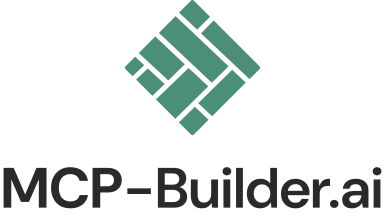Getting Started with MCP-Builder.ai

MCP-Builder.ai enables you to easily create and deploy your own MCP-Server with customizable configurations, multiple transport protocol options, and flexible deployment methods.
MCP-Builder.ai is using the powerful APICHAP framework. The underlying configuration language of APICHAP is used to build and connect your MCP-Server to other datasources. Check out the configuration pages to learn more about the Syntax.
How to Start Your MCP-Server Built with MCP-Builder.ai
MCP-Builder.ai supports various transport protocols and deployment functionalities to fit different use cases:
Supported Transport Protocols of the Model Context Protocol (MCP)
MCP-Builder.ai is based on the Model Context Protocol, a modern API standard optimized for real-time communication between model servers and clients.
Available Transport Protocols:
-
STDIO:
Standard input/output communication. Ideal for local development and testing environments.
✅ Supported in MCP-Builder.ai -
SSE (Server-Sent Events):
One-way communication protocol that streams events from the server to the client. Useful for updating clients with real-time data.
✅ Supported in MCP-Builder.ai
⚠️ Note: SSE is deprecated and will soon be replaced. -
HTTP-Streamable:
Modern, efficient protocol offering bidirectional streaming over HTTP.
🚫 Not yet supported in MCP-Builder.ai (Coming Soon)
How to Deploy Your MCP-Server
MCP-Builder.ai provides three primary deployment methods depending on your needs:
1. Run Locally Using STDIO
For quick setup and development purposes.
Requirements:
- Java 17 or higher installed on your system.
How to Run:
Depending on your client setup, you may need to configure the JAR file path in the client settings. For Claude Desktop Users:
Refer to the official quickstart guide: https://modelcontextprotocol.io/quickstart/user
2. Containerized On-Premise Installation
For production environments or private infrastructure deployments.
MCP-Builder.ai will ship your server as a ZIP package containing a pre-configured containerized application using Docker Compose or Podman Compose.
Requirements:
- Docker or Podman installed on your system.
How to Run:
- Unzip the package.
- Follow the instructions in the included README.md.
- Start your MCP-Server using:
- The provided startup script, or
- docker compose up / podman compose up.
Currently the container is exported using SSE protocol but will soon be replaced by the new HTTP-Streamable.
3. Run in MCP-Builder.ai Cloud (Coming Soon)
Easiest deployment option—hosted directly in MCP-Builder.ai Cloud.
Simply click "Run," and we handle the hosting of your HTTP-Streamable MCP-Server for you.
How to Use Your MCP-Server with Your Client
Once your MCP-Server is running, connect it to your preferred client.
Learn how to implement the MCP-Server with your client by following the official quickstart guide: https://modelcontextprotocol.io/quickstart/client